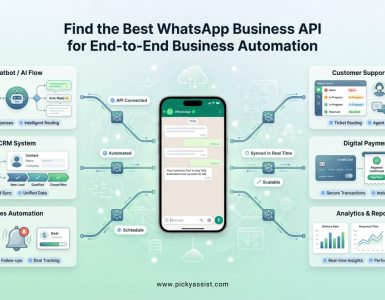After spending over twenty years guiding CRM system implementation across sectors, I’ve come to a sobering realization CRM implementation failure is not a result of software limitations or missing features. They fail because companies mistake them for a technology upgrade rather than an organizational transformation.
The truth is straightforward, yet often overlooked: the real success of any CRM software lies not in the tool itself, but in people, processes, and the company’s willingness to evolve.
In every boardroom I’ve been part of from fledgling startups to mature enterprises, the same mistake repeats. Teams hope the software will fix what strategy has never been clearly defined. But you can’t automate what you don’t fully understand.
Too often, leaders view CRM solution as a miracle cure, something that will automatically align data, teams, and revenue. That’s a dangerous illusion.
“A CRM is like an X-ray machine for your business. It reveals the fractures, but it can’t heal them for you.”
The Aspiration Trap: Why CRM implementation failure Before They Begin
I’ve watched this cycle unfold countless times, especially among first-time adopters and smaller organizations.
The first discussion usually begins with enthusiasm:
- “I want to automate everything with AI.”
- “I want to go fully digital.”
- “I want to measure every single thing.”
Those ambitions are commendable. But this is where what I call the Tool-First Mindset quietly sneaks in.
Leaders get so captivated by technology that they forget to define what problem they’re solving. As a result, they end up automating confusion instead of creating clarity.
When I ask, “What exact business outcome are you targeting?” or “What metric defines success?” Most decision-makers have no precise answer. Nearly 9 out of 10, in fact. Yet they’re ready to invest heavily in a system that accelerates them in the wrong direction.
“Automation doesn’t repair bad processes, it just makes them faster.”
The Hard Questions That Separate Success from CRM implementation failure
In my experience, CRM success doesn’t start with a software demo. It begins with tough, introspective questions that most businesses skip.
1. Define the Real ROI
When a CEO tells me, “I want to improve everything,” I immediately know the focus isn’t there. So I ask:
- Which single process, if automated, will create the most impact in the shortest time?
- Which key metric, conversion rate, deal size, churn rate, response time, needs to improve in the next year, and by how much?
Without a tangible goal, your CRM system will chase noise instead of results.
“If you can’t define success, your CRM solution will measure distraction.”
2. Establish Focus and Measurement
I often hear, “We want to measure everything.” My response is always the same. “Then tell me what you’ll ignore.”
Data without focus breeds chaos. I challenge leadership teams to answer:
- Which five metrics will you stop tracking tomorrow?
- Which three will you review every morning at 9 AM?
That’s where real clarity starts.
“Data isn’t power. Interpretation is.”
3. Assess Operational Readiness
This is where reality shows up.
When I ask teams to walk me through their lead management process, many realize they don’t have one documented. That’s when it becomes clear, the CRM system isn’t broken; the process is.
A CRM system can’t map what doesn’t exist. If workflows are inconsistent, all the system will do is institutionalize inconsistency. That’s why every company needs a process owner, someone responsible for documentation, training, and alignment.
“Software doesn’t fix disorders. Structure does.”
What Successful Leaders Do Differently with a CRM System
Across all my years, I’ve seen a clear distinction between companies that succeed with CRM system and those that struggle.
1. They Define Business Goals Before Selecting Software
Many organizations implement CRMs because “everyone else has one.” But technology without strategy only amplifies confusion.
“Don’t digitize chaos. Design clarity first.”
Visionary leaders tie CRM software goals directly to measurable results like reducing sales cycles by 25% or improving customer retention by 15%.
2. They Lead from the Top
CRM transformation isn’t an IT project, it’s a cultural movement.
When leaders champion the initiative, adoption thrives. When they don’t, the project dies halfway.
“People don’t follow software. They follow leadership.”
3. They Redesign Before They Digitalize
Trying to automate broken workflows is like building a skyscraper on weak soil. Successful teams simplify, standardize, and then digitize.
“CRM solution doesn’t change culture, it amplifies it.”
4. They Prioritize Data Discipline
Clean data doesn’t look glamorous, but it drives everything. “Garbage in, garbage out” isn’t just a saying, it’s a financial truth.
I tell every client: treat data hygiene not as a pre-launch task, but as a continuous business habit.
5. They Start Simple, Then Scale
The goal of Phase 1 isn’t perfection, it’s momentum.
Focus on the 20% of automations that create 80% of the value. Once your team adapts and gains confidence, expand from there.
Why Is This Mindset Shift Critical?
If you want your CRM system to truly deliver results, stop expecting success to come from fancier dashboards or better UI. It comes from alignment when leadership, processes, and technology all move in one direction.
A CRM software isn’t just a contact database; it’s a decision-making engine.
When you define success early, design processes around it, and ensure accountability, you’ll see faster deal closures, improved retention, and better forecasts.
But when strategy is unclear, even the most advanced CRM system amplifies confusion.
When CRM system Reveals the Truth
Let me share a few real-world stories that taught me invaluable lessons about CRM adoption. CRM implementation failure may be a result of simpler reasons.
Case 1: The Hospital Call Center
A hospital’s call center team proudly handled 100 patient follow-ups daily. After implementing CRM software, that number dropped to 80 and panic set in.
Management assumed the CRM solution slowed them down. But when we analyzed the system, the reality was different. The team wasn’t becoming slower; they were becoming accountable.
Earlier, no one tracked what happened post-call. Once the CRM system arrived, every call required recording the outcome answered, missed, or rescheduled. That “extra” step was visibility, not bureaucracy.
The CRM didn’t reduce efficiency; it revealed the truth.
“Digital maturity feels slower at first because you’re replacing motion with measurement.”
Case 2: The Study Abroad Consultancy
A study abroad agency approached us because they were losing leads across multiple channels, websites, WhatsApp, and social media.
Within two weeks, we unified their leads and deployed omnichannel chatbots for instant responses. Results were fantastic, faster conversions and happier clients.
But success brought impatience. They soon wanted to track every step of the student’s admission process far beyond sales. We advised a phased rollout, but they wanted everything, right away.
The new module worked technically. But employee adoption crashed. The system felt heavy.
That’s when they realized: technology moves fast, but people don’t. CRM implementation failure may be a result of these.
Case 3: The Hospitality Group
A hospitality chain wanted to go “fully digital” CRM system, chatbots, WhatsApp broadcasting, everything. Yet, a few weeks after launch, inquiries dropped.
When I investigated, the reason was clear. In their excitement to automate, they had paused all marketing campaigns, assuming automation would generate leads by itself.
That’s a classic misunderstanding.
“A CRM doesn’t create leads. It manages them.”
Automation enhances what already exists. It doesn’t replace your growth engine, it refines it.
Closing Reflections on CRM System
Technology rarely fails. What fails is how we interpret its early results.
When you automate, inefficiencies that were once hidden become visible, that’s not regression, it’s revelation.
A CRM journey isn’t a plug-and-play upgrade. It’s a shift from manual effort to measurable outcomes, from busyness to impact.
The initial slowdown you experience after implementation? That’s progress in disguising your organization learning to work with clarity instead of chaos.
“Automation doesn’t fix inefficiency. It exposes reality. What you do next decides whether your CRM becomes a breakthrough or a burden.”
At Picky Assist, we believe automation is not about tools, it’s about aligning people, processes, and purpose. Our all-in-one platform helps businesses streamline operations within an hour using AI-driven WhatsApp chatbots, modular CRM, TeamBox, broadcasting tools, drip campaigns, and no-code connectors.
Since 2018, we’ve earned the trust of over 2,000 businesses across 80+ countries, helping them boost productivity, increase sales, and reduce costs through an automation-first approach.
As an official Meta Partner, we continue empowering brands to connect, communicate, and convert transforming technology into true business growth.







Add comment